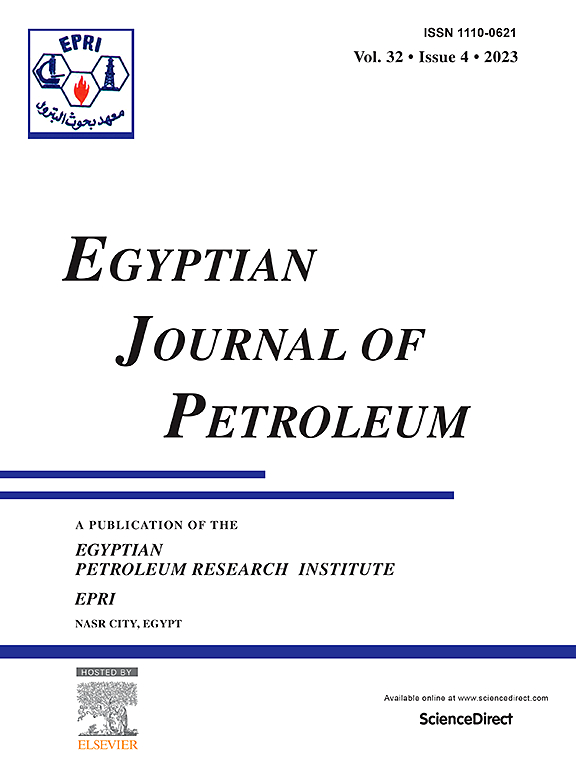监测埃及苏伊士湾海岸线土壤样本中脂肪族碳氢化合物的有机污染物
Q1 Earth and Planetary Sciences
引用次数: 0
摘要
这项研究的主要目的是评估苏伊士湾海岸线目前人为污染的程度,并将其与时间和地点相结合。这些油井污染主要是由于碳氢化合物处理不当,导致设备损坏、人为破坏和事故造成的水泄漏,最终污染地下水或将废物排放到苏伊士湾。从一个试验小区采集了 7 个复合沉积物样本。发现总石油碳氢化合物的浓度分别为 21.96、23.58、37.56、54.48、57.36、33.96 和 23.04 克/千克。碳氢化合物的分布情况由带有火焰离子化检测器的惠普(HP-7890 plus)气相色谱仪进行检测。正构烷烃的解析度(R c)分别为 0.088、0.087、0.193、0.091、0.099、0.123 和 0.177 m g/g。结果表明,碳氢化合物来自陆地输入。碳氢化合物的几种比率表明石油碳氢化合物占主导地位。高归一化脂肪族碳氢化合物浓度、未解决的复杂混合物的显著贡献、低正烷烃碳偏好指数和偶数至偶数碳数占优势都证明了这一点。因此,该地区的长期石油污染可能是由于大量的再生成物和所研究地区的水处理装置能力有限造成的。本文章由计算机程序翻译,如有差异,请以英文原文为准。
Monitoring organic pollutants from aliphatic hydrocarbons in Soil Samples within the shoreline in Gulf of Suez, Egypt
The principal goal of this research is to evaluate the current extent of anthropogenic contamination as a combination of both time and location in the shoreline in Suez Gulf. This oil re fi nery contamination was mostly the result of improper hydrocarbon disposal, which led to water leaks caused by equipment damage, vandalism, and accidents, which will ultimately pollute groundwater or release waste into the Gulf of Suez. Seven composite sediment samples were taken from a test plot. Total petroleum hydrocarbons were found in concentrations of 21.96, 23.58, 37.56, 54.48, 57.36, 33.96, and 23.04 g/kg, respectively. Hydrocarbons distribution were examined on a Hewlett-Packard (HP-7890 plus) gas chromatograph with a fl ame ionization detector. The resolved n-alkanes (R c ) were found to be 0.088, 0.087, 0.193, 0.091, 0.099, 0.123, and 0.177 m g/g. The results showed that the hydrocarbons are originated from terrestrial inputs. Several ratios of hydrocarbons indicated the predominance of petrogenic hydrocarbons. This was supported by high normalized aliphatic hydrocarbons concentrations; signi fi cant contributions of unresolved complex mixture; low n-alkane carbon preference index and even-to-odd carbon number predominance. Therefore, the chronic oil pollution in the area may be due to the large quantities of re fi ned products and the limited capabilities of water treatment units located in the studied areas.
求助全文
通过发布文献求助,成功后即可免费获取论文全文。
去求助
来源期刊

Egyptian Journal of Petroleum
Earth and Planetary Sciences-Geochemistry and Petrology
CiteScore
7.70
自引率
0.00%
发文量
29
审稿时长
84 days
期刊介绍:
Egyptian Journal of Petroleum is addressed to the fields of crude oil, natural gas, energy and related subjects. Its objective is to serve as a forum for research and development covering the following areas: • Sedimentation and petroleum exploration. • Production. • Analysis and testing. • Chemistry and technology of petroleum and natural gas. • Refining and processing. • Catalysis. • Applications and petrochemicals. It also publishes original research papers and reviews in areas relating to synthetic fuels and lubricants - pollution - corrosion - alternate sources of energy - gasification, liquefaction and geology of coal - tar sands and oil shale - biomass as a source of renewable energy. To meet with these requirements the Egyptian Journal of Petroleum welcomes manuscripts and review papers reporting on the state-of-the-art in the aforementioned topics. The Egyptian Journal of Petroleum is also willing to publish the proceedings of petroleum and energy related conferences in a single volume form.
 求助内容:
求助内容: 应助结果提醒方式:
应助结果提醒方式:


